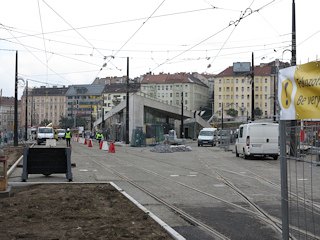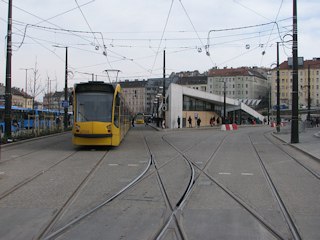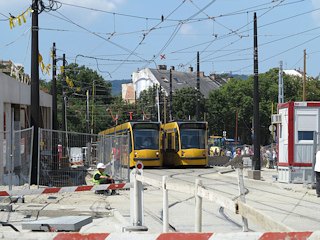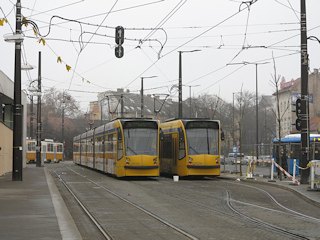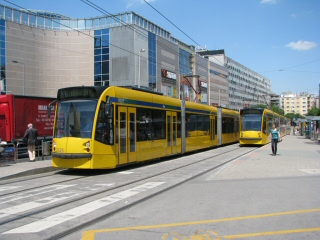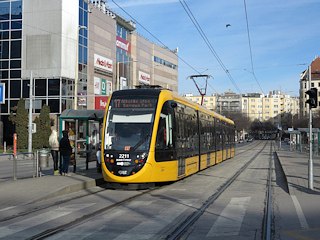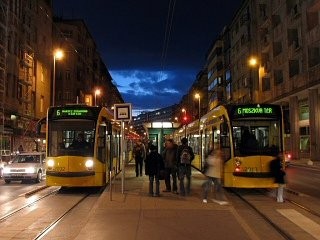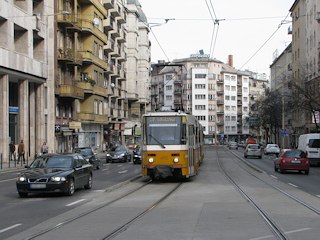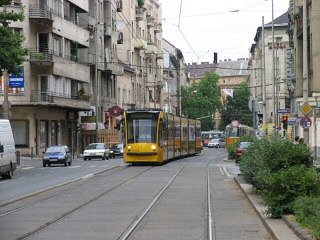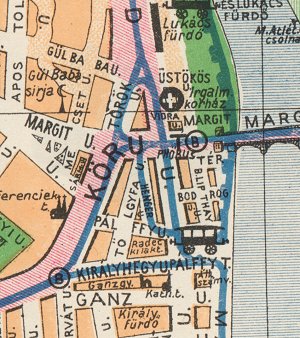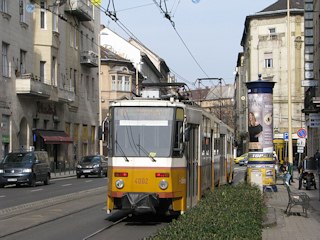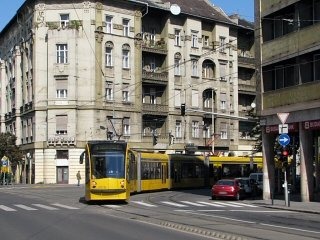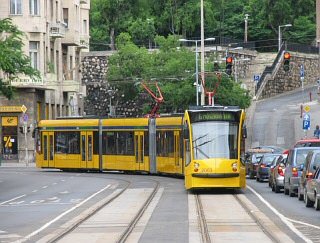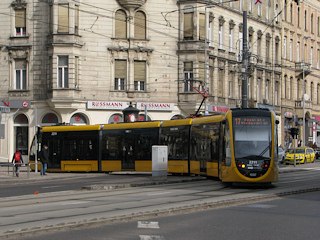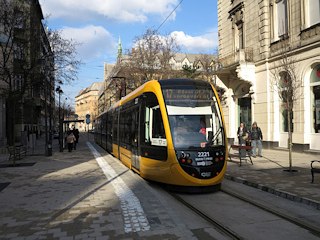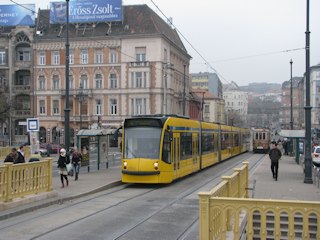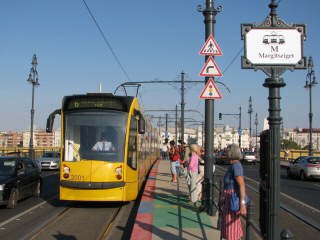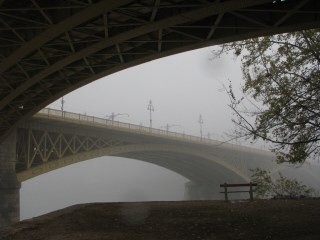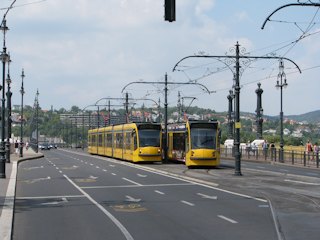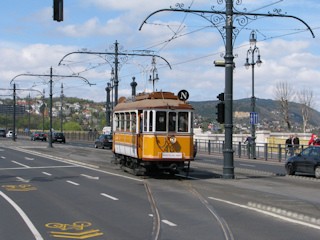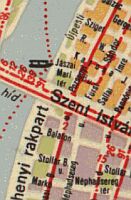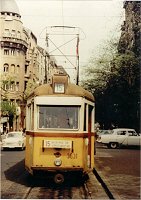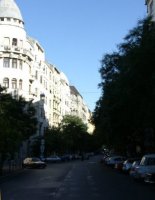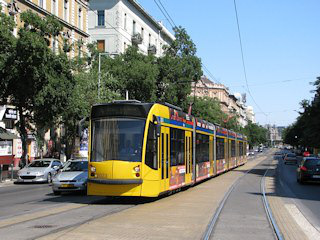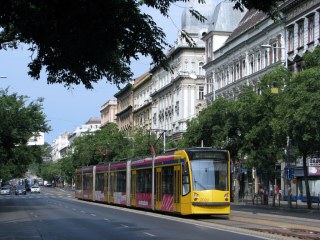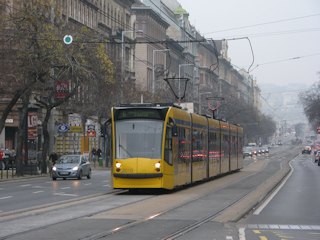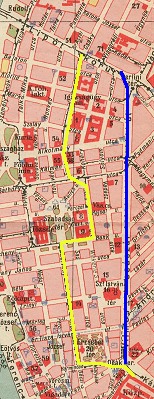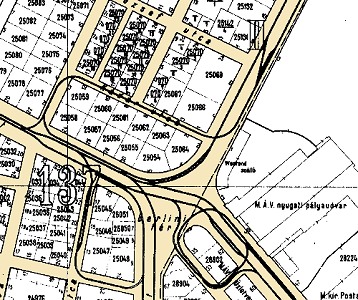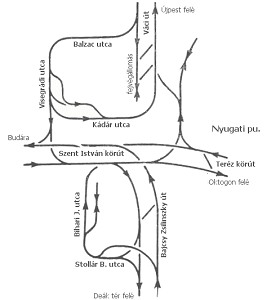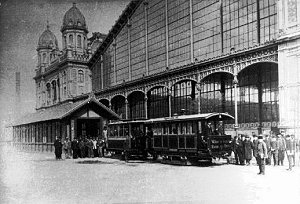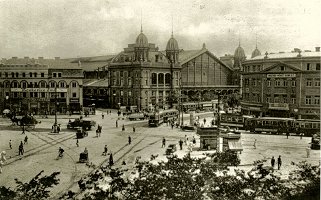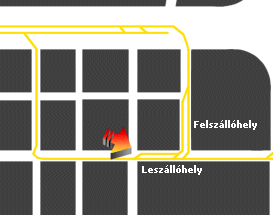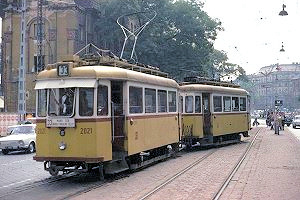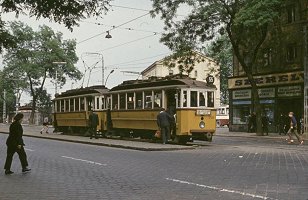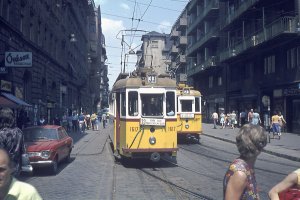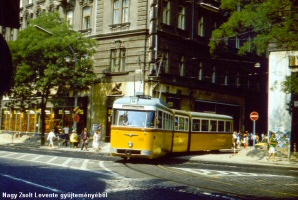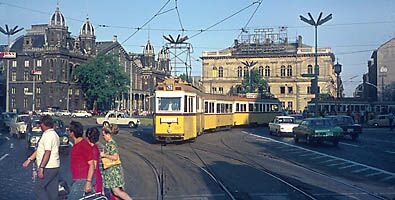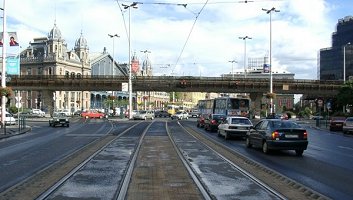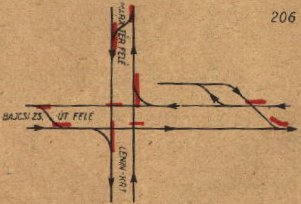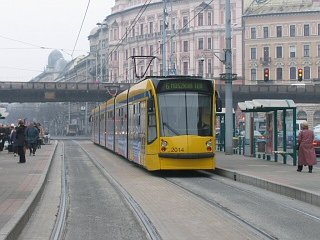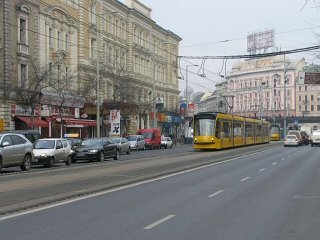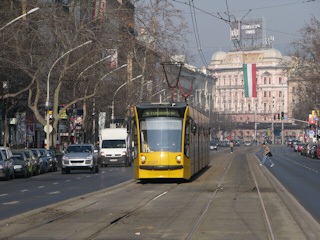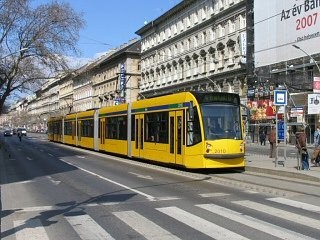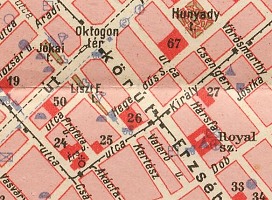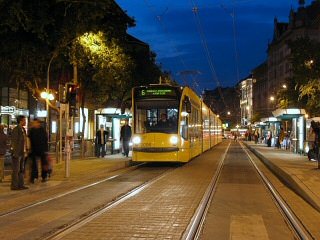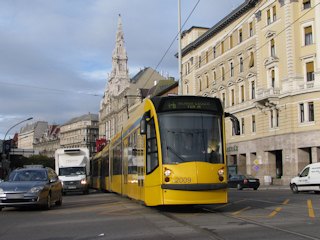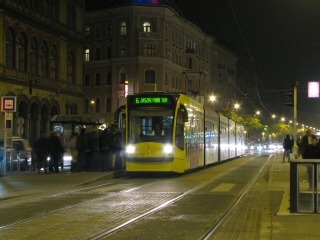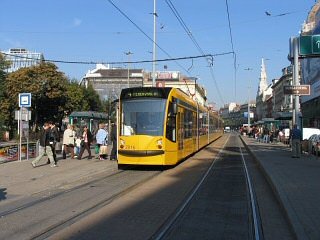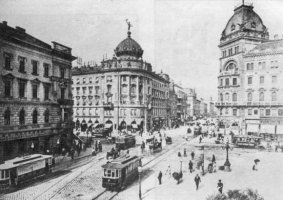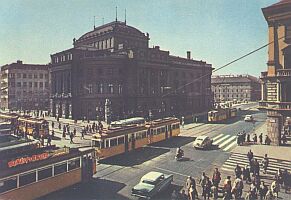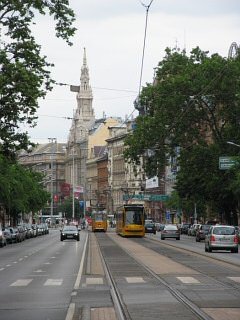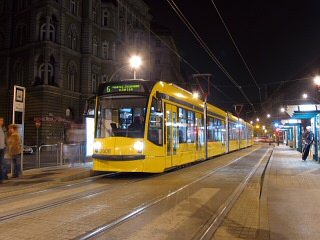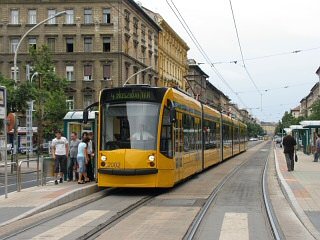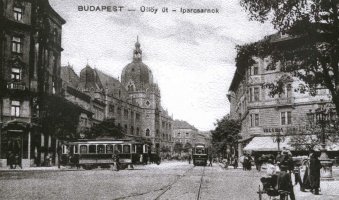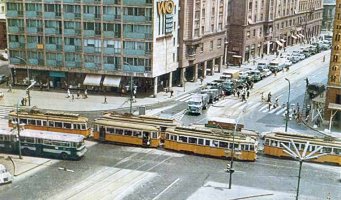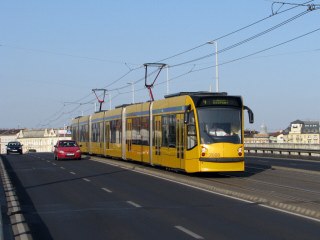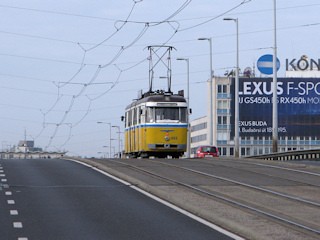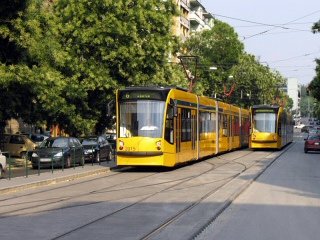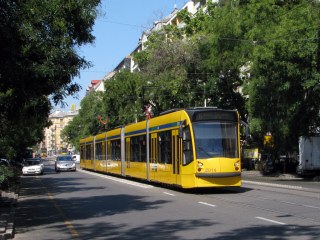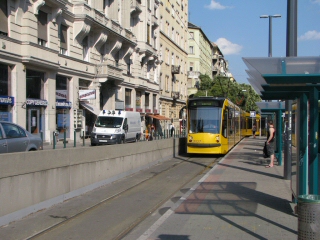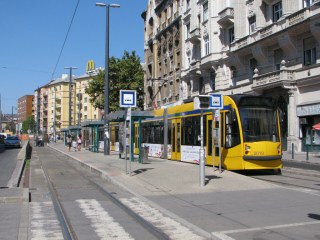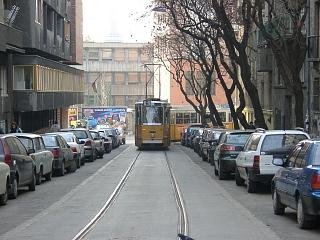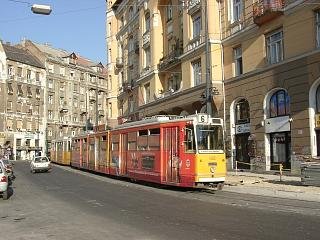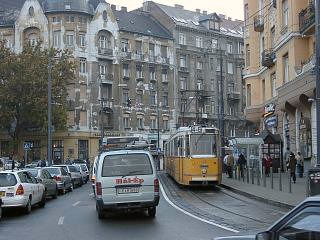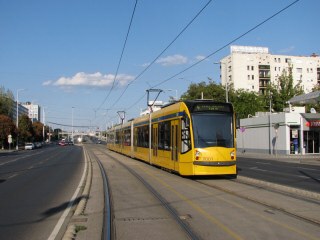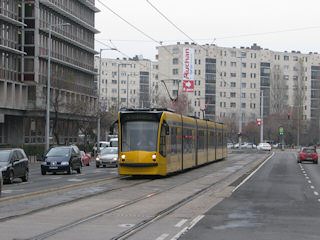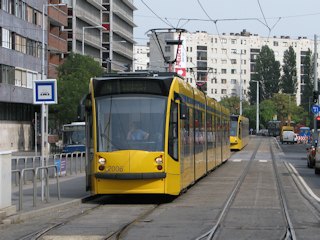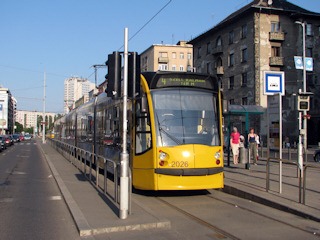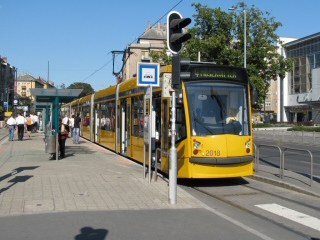Tram-hiker's
guide to Budapest
Latest update: 20. March,
2016
![]()
The Grand Boulevard is the birthplace of the Budapest electric tram: this is where the first such vehicle (designed and manufactured by Siemens&Halske) started its way from in front of the Nyugati pályaudvar (Western Station), and ran to the crossing of Király utca. All this on a meter-gauge track using conduit, built as an experiment to see if electric trams are feasible and safe.
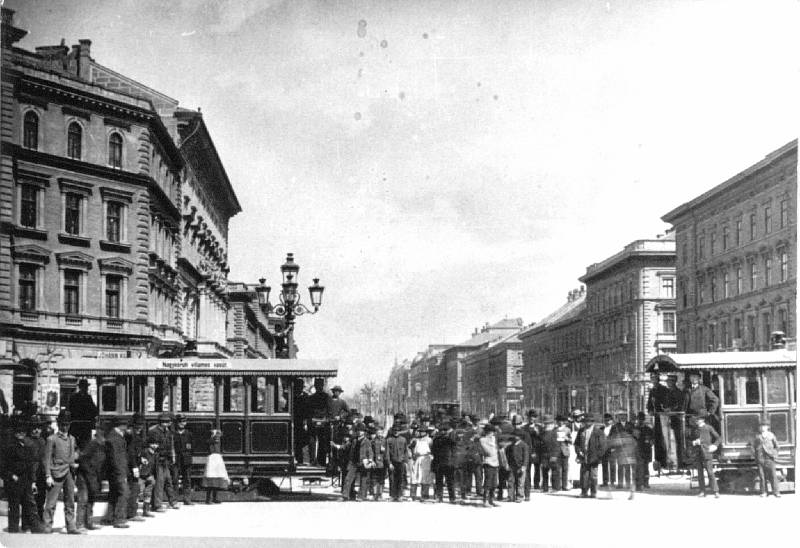
All three vehicles (two motorcars and one trailer, barely visible to the left) meeting at Oktogon in November 1887 - the same spot nowadays
The location was chosen because the yet incomplete Nagykörút (this word translates best into "Grand Boulevard", so I'm going to use it from now on) did not have any public transportation yet - other boulevards of the city were already served by horse trams. Upon the favorable reception of the experiment, the newly formed company BVV started to build the Grand Boulevard electric tramway in its then full length between Nyugati and Boráros tér, this time on normal (1435 mm) gauge.
What exactly are the "Grand Boulevard routes"?
The Grand Boulvard is a colloquial term. When we say it, we usually mean the Pest half-ring consisting of Szent István körút ("St. Stephen Boulevard" between Margaret bridge and Nyugati), Teréz körút ("Therese Boulvard" between Nyugati and Király utca), Erzsébet körút ("Elisabeth Boulevard" between Király utca and Blaha Lujza tér), József körút ("Joseph Boulevard" between Blaha Lujza tér and Üllői út) and Ferenc körút ("Franz Boulevard" between Üllői út and Petőfi bridge). The "Grand Boulevard tram routes" however do not end at the two ends of this half-ring, but continue on the other side of the Danube. Routes 4 and 6 only have two separate stops, in order to distribute the passenger load on the southern end.
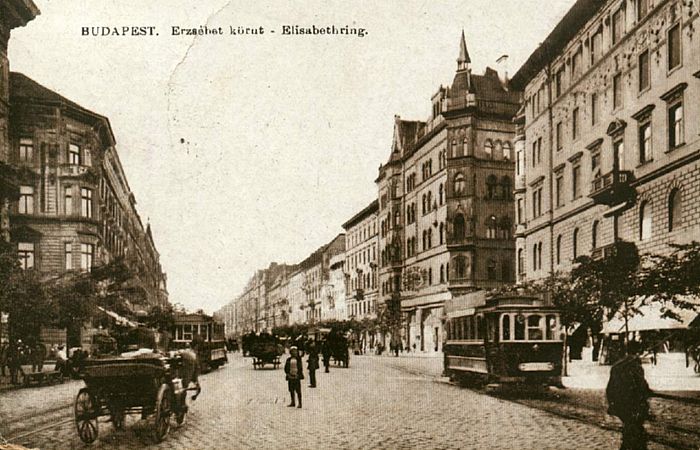
Trams at Wesselényi utca in the first years of the 20th century - the same spot nowadays
These two tram lines are vital to the city's life: their passenger load (more than 10,000 passengers/hour/direction during rush hours!) would call for an underground line, had not the main drain canal of the district be underneath the street surface. Until the middle of the 19th century, the streets we now know as the Grand Boulevard were a small water-course, which was the deepest point of the surroundings, so it was the best choice for a main catchment sewer tunnel to be built. There were voices suggesting that the small brook should be converted to a Venice/Amsterdam-style canal for ships, but it didn't happen.
Route 4: Széll Kálmán tér -
Széna
tér -
Margit körút - Margit híd - Szent István körút
- Nyugati tér - Teréz körút - Erzsébet körút
- József körút - Ferenc körút - Petőfi híd -
Irinyi
József utca - Október huszonharmadika utca - Újbuda-központ (Fehérvári
út) (8.6 km)
Route 6: Széll Kálmán tér- Széna tér -
Margit körút - Margit híd -
Szent
István körút - Nyugati tér - Teréz körút - Erzsébet
körút - József körút - Ferenc körút - Petőfi
híd - Irinyi József utca - Karinthy Frigyes út
- Móricz Zsigmond körtér 8.5 km
Here's a Google Maps overview of the route - the circular shape of the line can be very nicely seen:
Special remarks: The route runs almost entirely on tracks on semi-reservation. This is necessary, because the Grand Boulevard is usually congested all over the day. The result: despite infavorable traffic light timings, the tram is the quickest transportation method around here during rush hours (except when careless motorists are blocking the way of the tram in crossing streets). During the night route 6 keeps running with a 15-minute headway, so this is a 24/7 tram line (barring maintenance pauses).
![]()
Széll Kálmán tér (Moszkva tér until 2011)
The square was rebuilt in 2015/16, but the terminus of route 4/6 remained on its place, although with a different track layout.
These pictures show the current terminus being built. From the first bend routes 4 and 6 are sharing their way with tram 17 for two stops.
Hint: The Castle District is close to Széll Kálmán tér. You should take bus line 16/16A/116, you're there within minutes.
After only a few hundred meters we reach Széna tér, where an old-fashioned bus terminal and two large shopping centers are located. This is also where the Ganz Electric Works once operated - the company where (beside other things) most of the electric parts of hungarian trams were produced. Some of the buildings are still there in the form of the event park Millenáris, but the most striking remnants have been demolished in 2014/15, along with the modernist office building once fencing off the factory from Széna tér.
The stop Mechwart liget (named after an engineer - and later president - of the Ganz company) features a middle platform isle.
There are two major bends after this stop.The first is at Bem József utca. If you look at the Y-shaped turnout in the background of the picture to the left, you might guess that this used to be a junction for trams. From here on we ride through a quite narrow part of Margit körút (picture to the right). In fact, this street used to be so narrow that trams used it in one direction only - the other direction was winding its way through neighbouring streets: Bem József utca, Bem József tér, Frankel Leó utca and Henger utca.
| Lost
rails: Bem József utca (Királyhegyi utca on the map below)
Above you can see how trams (the blue-ish lines) were routed around here until 1937. This section was also part of the "Right Riverside Railroad" freight train route between the Szentendre HÉV (vicinal) line and Déli pályaudvar (Southern Station). Also, a tram depot used to exist near today's Bem József tér (then called Pálffy tér) in Feketesas utca/Tölgyfa utca: its remnants can be seen in the facade of a modern office building. |
Before reaching Török utca: north-bound tram 17 to the left, south-bound tram 17 to the right in the background.

Track layout (C) by Balázs
Fejes, from villamosok.hu
The biggest "attraction" of the interconnected tramway network launched in 2016 is the junction at Margit körút: trams on line 17 heading towards Széll Kálmán tér take a different street (Török utca) than trams of the same line coming from Széll Kálmán tér. (Frankel Leó út, joined by route 19 and 41 there).
-> To Török utca (south-bound route 17)
The sharp bend at the feet of the Rózsadomb (Rose Hill).
Frankel Leó út (north-bound route 17)
This is where the other direction of route 17 leaves Margit körút: with a left-turn into Frankel Leó utca.
-> Over to route 17 heading to north
Margit híd (Margaret bridge) is a Parisienne-style arch bridge designed designed by french architects in the 1870's as the second permanent bridge between Buda and Pest. It was built including tracks for the horse tram, but the tram companies of the already united cities were unable to negotiate who would operate this important connection, so the first train went over the bridge in 1879, after PKVT (the transit operator in Pest) bought BKVT (the transit operator in Buda). The bridge was rebuilt several times, including once after it was blown up by german troops in 1944 in the middle of rush-hour traffic (presumably by mistake).
The bridge was last renovated in 2010-12. This renewal included a widening (wider lanes, wider clearance for the tram, plus a bicycle lane), and the reconstruction of some old architectural elements that were not restored after WW2.
There's a stop in the middle of the bridge, at the side-bridge to Margit-sziget (Margaret island). There's also a 30-degree bend there, making the bridge quite special ("Y"-shaped).
Hint: Margaret island is a beautiful place to have a walk under the huge trees as a way of relaxing. There are also two public baths there, plus a small zoo.

Hint: The bridge is illuminated every night.
The other end of the bridge is Jászai Mari tér, named after a famous hungarian actress (1850-1926).
There's a crossover and a connection to route 2 between the bridge and the actual tram stop, but these are only used during temporary shortenings and unforseen events.
-> Link to the terminus of route 2 at Jászai Mari tér
The section between Jászai Mari tér and Nyugati pályaudvar still looks like how Grand Boulevard was planned in the 1870/80s.
It's hard to believe that this part of the city once housed mills and a few of the the most infamous pleasure-grounds!
The highlights of today are the antiquities shops in Falk Miksa utca, the Vígszínház (Comical Theater), cafes and confectioneries - with less grand second-hand shops and pizza places side-by-side.
Unfortunately it can be hard to take decent photos here, because the sun rarely shines deep enough into the street to shed nice light onto the trams and the background, too. And then there's also vehicular traffic getting in the way.
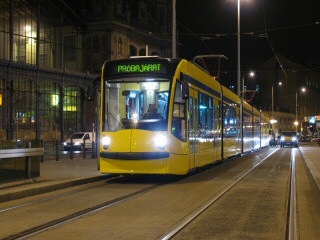
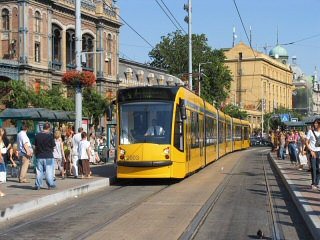
Left: the very first Combino
Plus (or Supra) on its first ride ever on the Grand Boulevard. To the right: now an every-day
moment in the same stop.
This wonderful railway station was designed by the best architects of the time (the fragile-looking iron roof frame was designed by the Eiffel (as in Eiffel Tower) Bureau for example), and built in 1877. The old railway station that used to stood here, was one of the most important stops of the first horse tram in 1866, as this institution was Budapest's first railway station, where the first railroad in Hungary started out from in 1846. The old building was in the way of the newly designed Grand Boulevard in the 1870's, so the new one - which you can see today - was built a bit to the north. Until the 1980's the place was not a real city square, but a street junction with very heavy public transportation load.
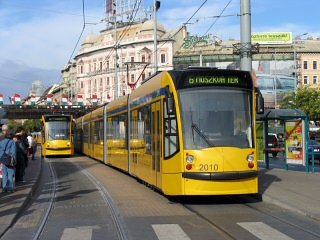
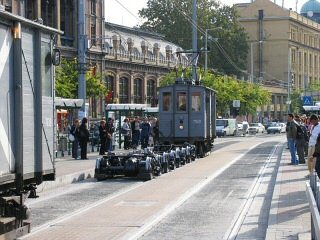
Regular and special vehicles
in the Nyugati tér stop
This is also where the first electric tram started out in 1887, and because of its importance as a traffic node, three reversing loops were built around the surrounding blocks. Between 1977 and 1982 the square was rebuilt: two buildings were demolished, to round off the sharp bend between Szent István körút and Teréz körút, and to make room for a new bus terminal and a parking lot.
Interestingly the originaly layout of the square - now called Nyugati tér, and known under various designations over the decades like Berlini tér (Berlin square), Vilmos császár tér (Emperor William square), Marx tér (after the father of communism) - was more of a deformed Y, because this was the point where the Grand Boulevard and the Small Boulavard (Kiskörút) - consisting of Bajcsy-Zsilinszky út, Károly körút, Múzeum körút and Fővám körút - diverged. The not really ring-shaped Small Boulevard was more important in the beginning, because its history reached back to hundreds of years, as it was built right around the medieval city walls of Pest. It was also BKVT horse-tram territory with Váci út as its continuation, just like Szent István körút and Margit híd, the first rail-bound link to Buda. The then-newly built Grand Boulevard however fell into the hands of the electric tram company BVV (later BVVV). This was a bit frustrating, because passengers arriving with BVVV services had had to change for BKVT services. And basically this stayed until the companies merged.
| Early
electric trams
-> More about the history of the trams around Nyugati pályaudvar |
Hint: although Nyugati pályaudvar has most of the unpleasant qualities of a large and overused railway station, it's worth to check out its architecture: the wooden roof held by the fragile cast-iron frame, the Royal Waiting Hall built for Emperor Francis Joseph the First, and the mostly-crowded ticket office in the same style. And the station also features what we probably should call the nicest McDonald's fast food restaurant in the world :-)
| Lost
rails: Váci út and the Visegrádi utca-Kádár utca "giant
loop"
Nowadays you won't see much tramlife around here except for route 4 and 6. Okay, they're probably the busiest tram service in Europe, but the place was far more full of trams when the Váci út routes still had their termini around here.
In the last decades, these routes were 3, 12, 14, 33 and 55. Normally route 33 had its terminus in the middle of Váci út, close to Nyugati tér, and the other routes went into a long reversing loop located in the narrow neighbouring streets (see drawings above). Of course from time to time there were exceptions, but the main rule stayed: unidirectional sets turned in the loop (marked with an arrow on the map on the left hand side), bidirectional ones at the stub track in Váci út (marked with an annor on the other map). The large reversing loop inside the streets was connected to the Grand Boulevard via Visegrádi út.
The Váci út trams were replaced by the M3 underground line in three stages between 1982 and 89. |
| Lost
rails: Bajcsy-Zsilinszky út
Bajcsy-Zsilinszky út (originally Váczi körút, then Vilmos Császár útja), Pest's entrance from north was part of the first horse-tram route in 1866 (together with Váci út). Because the rails in it belonged to the BKVT, most of the inner-city tram routes were dominated by this firm, while the other company, BVVV had tried to connect its other services via the Grand Boulevard, which "belonged" to them. The two companies' networks were united by the joint transportation company BSzKRt, but in the 1930's they separated Szent István körút from the rest of the Grand Boulevard again. It was united (again) after WW2. By the seventies, the jaws of Bajcsy-Zsilinszky út was terminus of route 47, 49 and 52, but there was no service that would continue from here, although the rail connection was still there. Note: this terminus was the remainder of a reversing loop in the neighbouring streets.
The Bajcsy-Zsilinszky út tram line was closed in 1980. Since then routes 47 and 49 terminate at Deák tér. |
Two more views around the tram stop:
... and now let's continue our way!
There's a crossover near the next stop Oktogon, used during temporary shortenings.
Oktogon (Octagon) was named after its shape. This is where the elegant Andrássy út and the illustrious Grand Boulevard cross each other. When you look at the way the road and the trams are crossing Andrássy út, you can notice the big hump, which is how the surface gets over the tunnel of the Milleneum Subway Line. The subway tunnel was built over the large sewer tunnel running under the Boulevard, hence the swell.
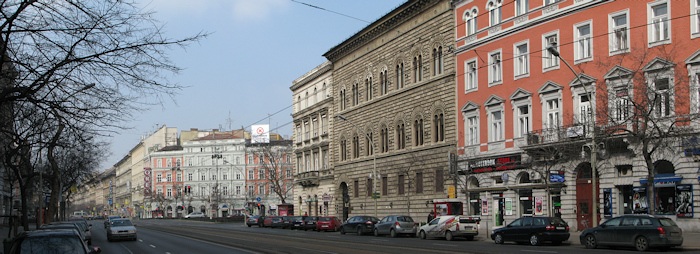
A panorama taken from south of Oktogon
Hint: it's worth to take a walk in Andrássy út, especially towards the Milleneum Monument at Hősök tere. Mansions, palaces, museums and villas are what you're going to see, all built with the will to express the spiritual superiority and newly-found wealth of Hungary inside the Austro-Hungarian Empire after the Compromise of 1867.


Morning and evening at Király utca

Panorama of the Grand Hotel Corinthia
| Lost
rails: Király utca
The second tram line of BVV to Városliget was opened in 1891 between Dózsa György út and the Grand Boulevard. It was then extended into the inner city in a couple of steps (1893 and 1906). In 1949 this was the fist tram line to be permanently supplemented with trolley buses (trolley line 70 to be exact - the route number was celebrating the 70th birthday of the soviet dictator Joseph Stalin.). |
The tram is crossed by trolley buses twice after Király utca: first at Wesselényi utca (line 74 inbound), then at Dohány utca (line 74 outbound). You are also passing by beautiful eclectic-style mansions, the magnificent Hotel Royal (it's now called Grand Hotel Corinthia, but to us it's just Hotel Royal), Madách Theatre, and the New York Palace.
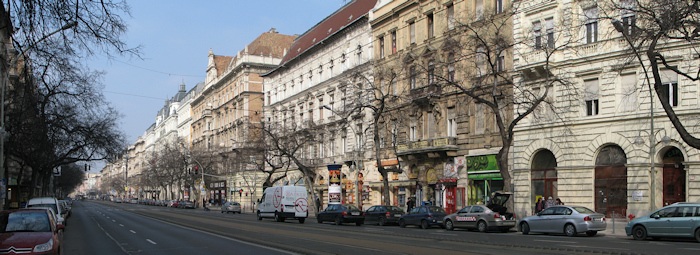
A typical view of the Boulevard around here
Our next big stop is at Blaha Lujza tér. This is where the Grand Boulevard crosses Rákóczi út, the busiest avenue of the inner city. This place wasn't a large square until the National Theater (earlier Popular Theater, built in 1875) was torn down in 1965. Unfortunately the square was not really trimmed ever since: something is missing, although some of the neighbouring buildings look quite magnificent. Another unfortunate thing: the small park in the middle is mostly occupied by homeless people.
Because of the metro line M2 and the tram routes 28, 37/37A and 62 coming from the suburbs this is the busiest stop of the Grand Boulevard routes. In rush hours you might not get a chance to get on board of the first incoming tram because of the herds of people going to and from different directions.
Hint: You should take some time, sit down and have a coffee in the recently renovated New York Palace, which is located on the corner of Dob utca and Teréz körút, somewhere between the stops Wesselényi utca and Blaha Lujza tér.
There's also a crossover located near the tram stop, and a connecting track to Népszínház utca, where routes 28, 37/37A and 62 run. This connecting track is used by the Grand Boulevard routes to enter service from depot Hungária, and of course by special runs and transports.
->
Over to the terminus of route 28, 37/37A and 62 in Népszínház utca
| Lost
rails: Rókus kórház and route 2
The Grand boulevard was once crossed here, too, first by the steam tram going to Új Köztemető (the line that later became tram route 37), then by route 2. Also, some routes have had their terminus on the other side of the square in form of a reversing loop around the department store now called "Centrum Corvin" (covered in ugly aluminium sheets). The name of the old terminus "Rókus kórház" refers to the old, but still functioning hospital located next to the department store. The terminus of the routes ending here was moved to its current location in Népszínház utca so that they won't obstruct the Grand Boulevard routes while crossing their tracks. |
The next section of the Boulevard gets a bit less patrician. Some of the most down and out parts of the city are only a few streets away from here. It's not near as bad as it was twenty-odd years ago, but the rehabilitation of those inner city skid rows goes slowly.
I hope a bit of urban folklore does not ruin your appetite for more Budapest: Rákóczi tér and the neighbouring streets were the center of the "red-light business" in the communist days, and therefore it was considered a quite infamous place. That's over now, and the nice old market hall from 1894 might give you a hint that once this was a blooming downtown area.
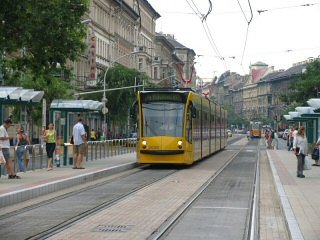
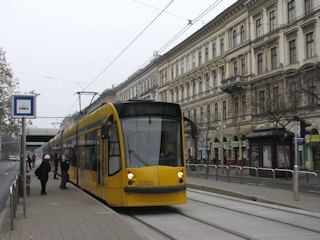
The stop at Harminckettesek tere (formerly known as Baross
utca)
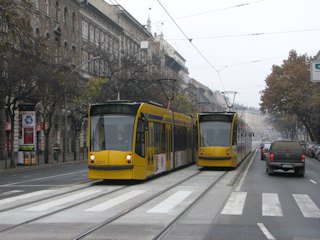
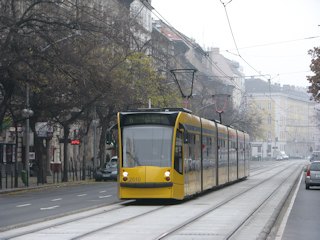
The tracks were replaced around here in 2012, this can be recognised on the different surface covering (concrete instead of asphalt)
Corvin-negyed (formerly Üllői út)
And our next stop is again of "lost rails" fame. As for the present, this is a stop, in which you will very likely see two south-bound trams standing in a row. There's also a crossover at the northbound platform, so if there's a service disruption, this is one of the places where trams can reverse.
Hint: the Museum of Applied Arts is located in a characteristic "hungarian art nouveau" building nearby. You can see it on the picture above to the left.
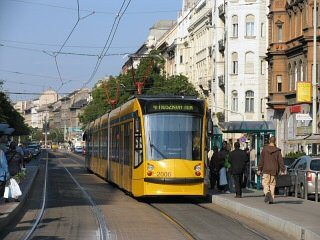
To the left: the stop at
Mester
utca.
Our next stop is where you can change to tram line 51 or 51A, which have a stub terminus in Mester utca, perpendicular to the Grand Boulevard. This is where depot runs of route 4 and 6 leave their normal route for depot Hungária.
-> Over to the terminus of route 51/51A (formerly 21/21A) in Mester utca
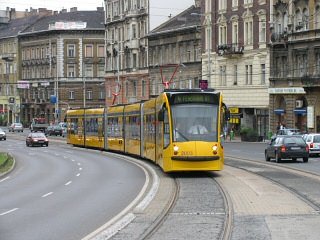
Combino climbing the ramp
to the bridge
Boráros tér was the southern endpoint of some Grand Boulevard routes until Petőfi híd (bridge) was opened in 1937. The square was also crossed by some north-to-south services. After WW2 it was the southern end point of route 2, and northern end point of some tram routes heading for South-Pest. It also became the end point of the Csepel Suburban Railway in 1951, and more and more buses during the decades until it became a vital traffic node for southern Pest.
Hint: The trams of route 4 and 6 are hard to photograph from the pavements of the bridge because of the heavy car traffic, but you can take nice pictures of route 2 trams running beneath.
-> Link to route 2 and 2A at Boráros tér
This bridge is one of the newer ones, it was opened in 1937. It was blown up in WW2, just like the others, and was then rebuilt, just like the others.
The bridge has a dominant bulge, which can be made even more dramatic with a telescopic lense :)
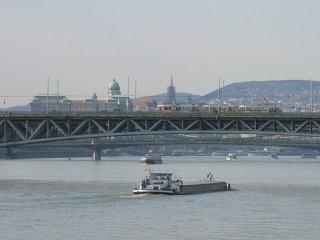
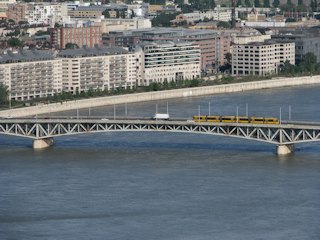
Two views of Petőfi híd: one taken from Lágymányosi híd, and one from Gellért-hegy
Hint: From Petőfi híd you can take wide panorama views of the city, Buda Castle, Szabadság híd (Liberty Bridge), with the Buda Hills in the background!
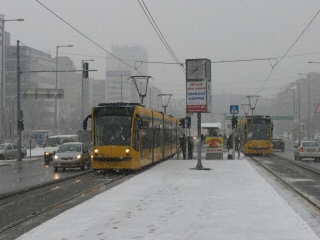
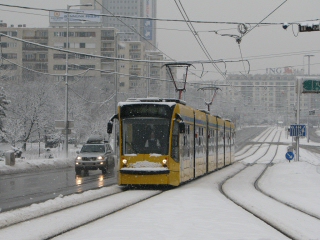
The Goldmann György tér stop during winter
Hint: the junction is a nice photo-site, but be careful for the vehicular and tram traffic!
And now comes the point where route 4 and 6 part ways: the first goes straight forward in Irinyi József utca, while the latter turns right, into Karinthy Frigyes út.
The stretch in Karinthy Frigyes út can be nice with all the trees - under the right lighting conditions.
The Móricz Zsigmond körtér terminus
The reversing loop (see below) was abandoned in May 2006, since then the terminus is a two-track stub, slightly recessed into the ground.
-> Link to Móricz Zsigmond körtér
The separate section of route 4
The separate section of route 4 runs in Irinyi József utca ...
... and Október 23. utca. It only has one stop before the terminus, called Budafoki út/Szerémi sor.
The terminus of route 4 at Újbuda-központ (formerly Fehérvári út)
The reason behind the "Y"-shaped line endings was to lift some traffic off of Móricz Zsigmond körtér. Until 1972 route 4 turned onto Fehérvári út and went all the way to Budafok. Now it's just a two-track stub terminus with a connecting track to the Fehérvári út lines for special runs.

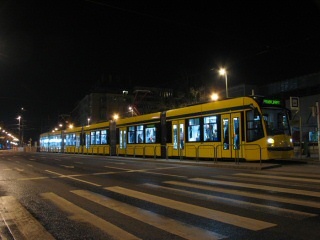
Night shot of the
very first Combino at this terminus
The Fehérvári út terminus of route 4 was reshaped in 2003, and then in 2006 for the Combinos.
-> Over to the Fehérvári út trams
![]()
Back to the
top
Back
to the opening page
Disclaimer: The author cannot
be held responsible for mistakes, misinterpretations, inaccuracies, inactualities,
etc. on/of these pages, nor for the content of other pages linked in.
![]()
Send
a mail to the author
The
author's homepage
